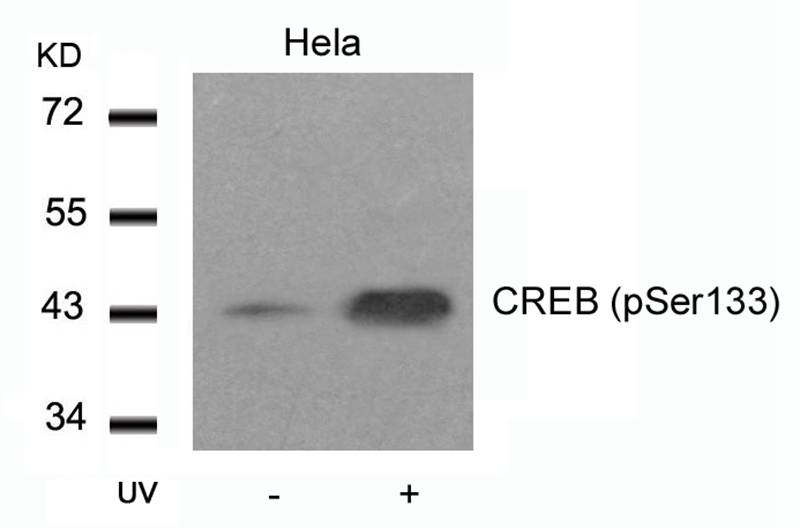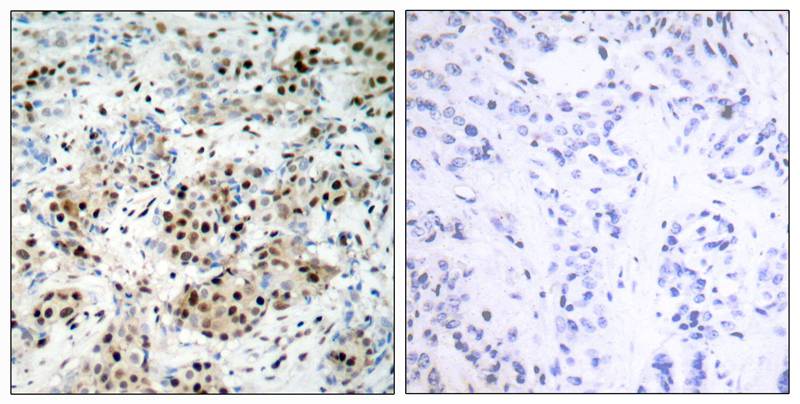

| WB | 咨询技术 | Human,Mouse,Rat |
| IF | 咨询技术 | Human,Mouse,Rat |
| IHC | 1/50-1/100 | Human,Mouse,Rat |
| ICC | 技术咨询 | Human,Mouse,Rat |
| FCM | 咨询技术 | Human,Mouse,Rat |
| Elisa | 咨询技术 | Human,Mouse,Rat |
| Aliases | CREB-1; CREB1; |
| Entrez GeneID | 1385; |
| WB Predicted band size | 43kDa |
| Host/Isotype | Rabbit IgG |
| Antibody Type | Primary antibody |
| Storage | Store at 4°C short term. Aliquot and store at -20°C long term. Avoid freeze/thaw cycles. |
| Species Reactivity | Human,Mouse,Rat |
| Immunogen | Peptide sequence around phosphorylation site of serine 133 (R-P-S(p)-Y-R) derived from Human CREB. |
| Formulation | Purified antibody in PBS with 0.05% sodium azide. |
+ +
以下是关于CREB(Phospho-Ser133)抗体的3篇参考文献的简要总结:
1. **文献名称**:*CREB phosphorylation and dephosphorylation: A Ca²⁺- and stimulus duration-dependent switch for hippocampal gene expression*
**作者**:Deisseroth K. et al.
**摘要**:研究通过免疫印迹(Western blot)使用Phospho-Ser133抗体,验证CREB在钙信号激活后的磷酸化状态,揭示了神经元中CREB活性与基因转录的时间依赖性调控机制。
2. **文献名称**:*A role for phosphorylated CREB in adult neurogenesis and plasticity*
**作者**:Nakagawa S. et al.
**摘要**:通过免疫组织化学(IHC)结合Phospho-Ser133抗体,证明CREB磷酸化对海马区神经干细胞分化和突触可塑性的关键作用,为学习记忆的分子机制提供证据。
3. **文献名称**:*Regulation of CREB phosphorylation by acute and chronic morphine treatment in rat brain*
**作者**:Shaw-Lutchman T.Z. et al.
**摘要**:利用Phospho-Ser133抗体检测吗啡处理对大鼠脑区CREB磷酸化的影响,发现急性和慢性药物暴露导致CREB活性差异,提示其在成瘾行为中的双重调控。
这些文献均通过Phospho-Ser133抗体检测CREB的激活状态,应用于神经科学、信号通路及疾病机制研究。如需具体实验细节,建议查阅全文方法部分。
The CREB (Phospho-Ser133) antibody is a key tool for studying the activation status of the cAMP response element-binding protein (CREB), a transcription factor critical for cellular processes like neuronal plasticity, memory formation, and survival. CREB becomes functional when phosphorylated at serine 133 (Ser133), a modification triggered by kinases such as PKA, MAPK, or MSK1 in response to extracellular signals (e.g., growth factors, hormones, or stress). This phosphorylation enables CREB to recruit coactivators like CBP/p300. initiating transcription of target genes involved in cell growth, differentiation, and adaptive responses.
The antibody specifically detects CREB only when phosphorylated at Ser133. distinguishing it from the inactive, non-phosphorylated form. It is widely used in techniques like Western blotting, immunofluorescence, and immunohistochemistry to map CREB activation dynamics in diverse contexts, including synaptic plasticity, circadian rhythm regulation, and cancer progression. Researchers employ it to investigate signaling pathways (e.g., cAMP/PKA or BDNF/TrkB) and disease mechanisms, such as CREB dysregulation in neurodegenerative disorders or tumors. Its specificity and reliability make it essential for linking cellular signaling events to gene expression changes in both physiological and pathological states.
×